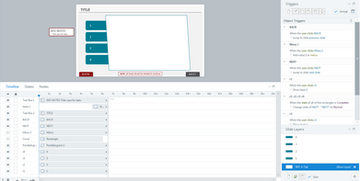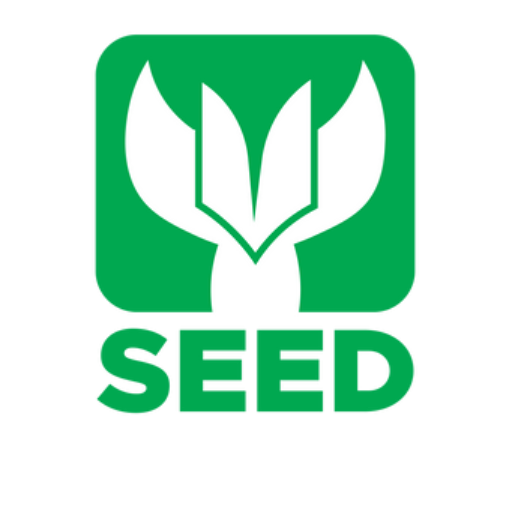The first venture into developing an e-learning templates will often result in simple interactions, and minimal animations. These templates are often used from the standard templates included in the software. For rapid development, these templates provide a great design aesthetic and several interaction types to choose from. This provides a great resource for beginners to get a project started very quickly. They also often include training elements such as basic triggers, layers, shapes, and formatted text boxes. Often times, these templates can be used to create any training you have in your project list.
However…
The problem is that these basic e-learning templates introduce additional problems. When using pre-packaged templates (e.g. “off the shelf”) from the software, and even those templates purchased from vendors, SEED has discovered many areas for improvement. Here is just a small list of items we have uncovered during a template review:
- Object states are inconsistent with colors, fonts, sizes, or shapes.
- The text boxes, shapes, graphics, etc. naming conventions do not make sense. Therefore, to further modify the template slides, often requires an extensive re-work
- The slides do not include animations
- The pre-built interactions are usually limited to tab, basic drag and drop interactions, and assessment type questions
- The sizing is not compatible, or does not resize for various slide designs
This is just a small list of the issues we have discovered with pre-packaged e-learning templates. And if an issue isn’t discovered right away (e.g. an incorrect hover state), can you put a number on the amount of hours that will be needed if you’ve used that interaction 20 times in your course? In an environment of shortening deadlines and high expectations, this could seriously harm your training budget.
At SEED, we focus on building our custom e-learning templates according to the client specifications. We create simple designs which are visually appealing. We focus on efficient designs which can be picked up by any developer with ease. And we aim to create a template which is engaging for the learner.
- Accordion
- Bulletin board
- Checklist
- Circle diagram
- Conversation
- FAQ
- Folder
- Glossary
- Guided image
- Image zoom
- Labeled graphic
- Labeled panel
- Media panel
- Media tour
- Process
- Pyramid
- Quick choice
- Tabbed image
- Tab
- Timeline
Sometimes a more complex custom interaction is needed. This could include: a simulation, use of variables and multiple files, or even advanced JavaScript. Our goal when creating a custom e-learning template is to give your employees a connection to the training. This will encourage them to engage with an environment familiar to their workplace.
Just imagine creating training for an employee which puts your company at the forefront of the design, and then builds a seamless transition between your website and their development within your business. This is a very important element to all employee engagement and retention, the ability to absorb a company’s culture into the various content they are exposed to when working for a company.
Continue reading to learn how our templates will help your team absorb your company’s ideas and goals. These are also incredibly useful tips we have compiled from client feedback to improve your template creation.

Why do you want a SEED custom e-learning template?
Simple design – Our templates use a simple, but very efficient numbering system. This eliminates guess work when building content. The numbered objects link to numbered layers (if applicable), fostering rapid development by your team (or our custom course creation team).

Object states – Object states are simple additions which provide visual cues to help learners progress through the course. “Hover” states give clues for clicking and interaction. “Complete” states give the learners the sense of accomplishment within slides. NOTE: While the “visited” state is useful, we have often found it cumbersome and buggy in e-learning software

Slide triggers – Most e-learning templates include the following triggers. “Hide layer” and “Show layer”. They then rely on the buggy “Visited State”. We have done away with the problems that pesky “visited” state invites, and then subsequently created custom states that will work every time for your learners.

Animations – We attempt to animate every object that makes sense. A simple fade, wipe, or fly in animation really makes an e-learning course template shine. Advertisements, YouTube videos, and media use animation. You’re training should as well. Want to see the how great animations feel in training? check out our Active Shooter course.

NEXT and PREV – Most templates rely on the standard NEXT and PREV buttons. At SEED, we prefer custom buttons. This is a great way to incorporate company icons and company colors with every learner click. The custom buttons provide an engaging way to guide learners through the course, and it’s far more appealing than the standard buttons.

Custom menu – A custom e-learning menu really gives the e-learning module a unique feel. When your learners take the course, they will know that you didn’t just push out some easy training. They will know you spent the money and the time to develop this training they have been assigned.

The 6 items listed above are all included on our custom e-learning templates. We also include developer notes for easy implementation into your content. Contact us to request information about how our custom e-learning template could take your training curriculum to the next level. Still unsure? Contact us for a free e-learning template.
NOTE: We are currently only offering a free e-learning template for Articulate Storyline





